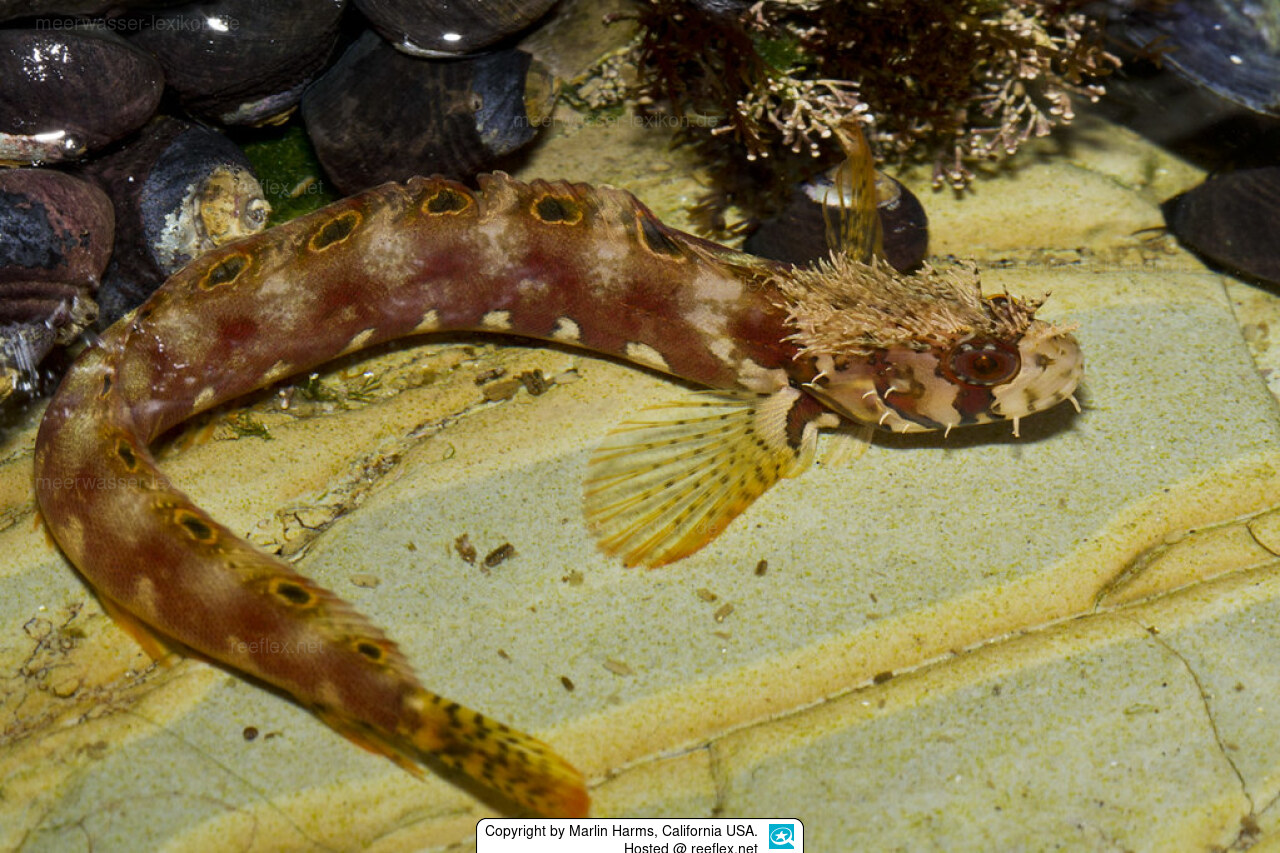Info
Chirolophis nugator (Jordan & Williams, 1895)
Usually in rocky areas , hides in crevices and tubeworms holes with only head protruding. Feeding on small fish and invertebrates.,
The Chirolophinae are a subfamily of the spiny ridges (Stichaeidae) in the partial order of the eel mother relatives (Zoarcales). All twelve species in the group are bottom-dwelling marine fish found in the cool waters of the northern Pacific Ocean.
They have an elongated body covered with scales, the head being scaleless. Very little is known about the life of these animals.
Chirolophis nugator grows to 15 cm in size and is usually found in rocky habitats. The mosshead often hides in holes, crevices, and tube-worm tubes, so that only the head is visible. The blenny is variable in colour from light brown to light red. It is said to be very shy. Divers report that Chirolophis nugator can also be found in empty bottles, which unfortunately lie in the sea as garbage.
Chirolophis nugator feeds on small fish and invertebrates and is itself prey to larger fish.
Synonymised names:
Bryostemma nugator Jordan & Williams, 1895
Jumping guard
A jumping guard prevents (nocturnal) fish from jumping out.
Wrasses, blennies, hawkfishs and gobies jump out of an unprotected tank in fright if their night rest is disturbed, unfortunately these jumpers are found dried up in the morning on carpets, glass edges or later behind the tank.
https://www.korallenriff.de/en/article/1925_5_Jump_Protection_Solutions_for_Fish_in_the_Aquarium__5_Net_Covers.html
A small night light also helps, as it provides the fish with a means of orientation in the dark!
Usually in rocky areas , hides in crevices and tubeworms holes with only head protruding. Feeding on small fish and invertebrates.,
The Chirolophinae are a subfamily of the spiny ridges (Stichaeidae) in the partial order of the eel mother relatives (Zoarcales). All twelve species in the group are bottom-dwelling marine fish found in the cool waters of the northern Pacific Ocean.
They have an elongated body covered with scales, the head being scaleless. Very little is known about the life of these animals.
Chirolophis nugator grows to 15 cm in size and is usually found in rocky habitats. The mosshead often hides in holes, crevices, and tube-worm tubes, so that only the head is visible. The blenny is variable in colour from light brown to light red. It is said to be very shy. Divers report that Chirolophis nugator can also be found in empty bottles, which unfortunately lie in the sea as garbage.
Chirolophis nugator feeds on small fish and invertebrates and is itself prey to larger fish.
Synonymised names:
Bryostemma nugator Jordan & Williams, 1895
Jumping guard
A jumping guard prevents (nocturnal) fish from jumping out.
Wrasses, blennies, hawkfishs and gobies jump out of an unprotected tank in fright if their night rest is disturbed, unfortunately these jumpers are found dried up in the morning on carpets, glass edges or later behind the tank.
https://www.korallenriff.de/en/article/1925_5_Jump_Protection_Solutions_for_Fish_in_the_Aquarium__5_Net_Covers.html
A small night light also helps, as it provides the fish with a means of orientation in the dark!







 Marlin Harms, California USA, California, USA
Marlin Harms, California USA, California, USA












